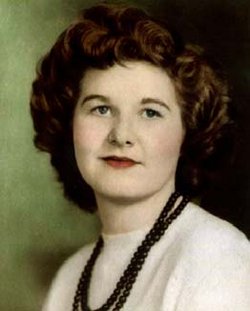Jean Bartik (Jean Bartik)

In 1945, the Army was recruiting math majors for the war effort; her faculty adviser noticed a job advertisement for an Army project in Philadelphia and suggested Bartik apply. She was hired by the University of Pennsylvania to work for Army Ordnance at Aberdeen Proving Ground to calculate ballistics trajectories by hand as a human “computer.” While working there, Bartik met her husband, William Bartik, who was an engineer working on a Pentagon project at the University of Pennsylvania. They married in 1946 and divorced in 1968.
When the Electronic Numeric Integrator and Computer (ENIAC) was developed for the purpose of calculating these same trajectories, Bartik applied to become a part of the project and was eventually selected to be one of its first programmers. Bartik and the other five original programmers became extremely adept at running the ENIAC, after learning how the machine worked only by reviewing diagrams of the device and by talking to its engineers: there was no manual. Initially, they were not allowed to see the ENIAC at all since it was still classified and their clearance hadn’t gone through, so they had to learn how to program the machine solely through schematic diagrams.
Bartik later became part of a group charged with converting the ENIAC into a stored program computer: in the original implementation, ENIAC was programmed by setting dials and changing cable connections. After the end of the war, she went on to work with the ENIAC designers John Eckert and John Mauchly, and helped them develop the BINAC and UNIVAC I computers. Recalling her time working with Eckert and Mauchly, she described their close group of computer engineers as a “technical Camelot.”In 1951, the same year the UNIVAC was introduced, Bartik left the industry to raise her three children. Bartik was a friend of over 60 years with John Mauchly’s widow, Kathleen “Kay” Antonelli. He walked Jean down the aisle when she married and it was at Jean’s wedding reception that he had the courage to approach Kay about dating.[citation needed] Kay was also one of the six original women programmers of the ENIAC.
In 1967, Bartik returned to the working world and became an editor for Auerbach Publishers, an early publisher of information on high technology. She left Auerbach to join Data Decisions, a competitor to Datapro Research (now part of the Gartner Group) and Auerbach. Data Decisions was founded in 1980 by Elizabeth McKeown Sussman (formerly of Datapro) and Sandra Eisenberg, also of Datapro. Data Decisions was funded by Ziff-Davis Publishing in 1980. Jean joined Data Decisions in 1981 where she was a Senior Editor for the Communications Services research publication. Data Decisions was acquired by McGraw-Hill (then owners of Datapro) in 1985 and promptly shut down. Having lost her job at the age of 61, Bartik was unable to find any more work in the computer industry and instead began a new career as a real estate agent, which she remained in for most of the rest of her life. She died from congestive heart failure on March 23, 2011.
In 1997, Bartik was inducted into the Women in Technology International Hall of Fame, along with the other original ENIAC programmers. In 2008, she was made a Fellow of the Computer History Museum “for contributions as one of the first programmers of the groundbreaking ENIAC computing system in 1945, and for further assistance in converting the ENIAC system into one of the first stored-program computers.” That same year, she also received the IEEE Computer Pioneer Award from the IEEE Computer Society, for “pioneering work as one of the first programmers, including co-leading the first teams of ENIAC programmers, and pioneering work on BINAC and UNIVAC I.” She also received the Korenman Award from the Multinational Center for Development of Women in Technology (MDWIT).
Bartik has a museum in her name at Northwest Missouri State University in Maryville, Missouri. The museum boasts rare one-of-a-kind ENIAC, BINAC and UNIVAC exhibits, including an original salesman pot-metal model of the UNIVAC I. In addition to a BS in mathematics from Northwest Missouri State Teachers College, Bartik held an MS in English from the University of Pennsylvania and an honorary Doctor. of Science from Northwest Missouri State University.
Born
- December, 27, 1924
- USA
- Gentry County, Missouri
Died
- March, 23, 2011
- USA
- Poughkeepsie, New York
Cemetery
- Jennings Cemetery
- Stanberry, Missouri
- USA

